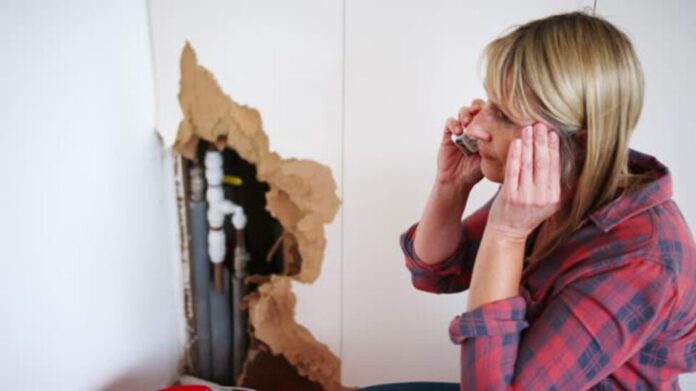For homeowners, water damage can be a nightmare, but it can be even more of an issue for businesses. In the absence of timely intervention, commercial water damage can result in significant revenue losses. Numerous factors can cause commercial water damage, and we’ll go over the most typical culprits below.
Here are the primary causes of water damage and how otherwise you can repair them, as these tips and tricks will always come really handy for you always.
Leak and flood hazards are not the only dangers to your commercial property; they include the following as well:
Water Leaks in the Pipes
The majority of water damage in a home may be traced back to problems within the plumbing system, specifically leaks. When pipes rust, corrosion occurs, and this can lead to leaks. Additionally, water leaks can be caused by high water pressures, weak pipe joints, excessive temperatures, and faulty water hoses. Natural calamities could have impacted your system.
Water leaks, however, can be challenging to find since they might occur in places that are difficult to access, such as under the sink. Water damage can be avoided if leaks in the plumbing system are discovered and repaired as soon as possible.
Gutters that are clogged
Tree leaves, weeds, ice, and sludge are among the most common causes of clogs. Because so few people bother to clean their gutters, debris builds up and eventually clogs the pipes.
A clogged gutter causes water to collect, and this excess water overflows into areas near the house’s structure, where it can cause damage. You may also find the mold and a foul odor in your basement if this water accumulates there.
Keep an eye out for roof leaks, especially if your workplace is on the top story of a structure. Water might accumulate in your home if there are leaks in the roof.
Equipment or Appliances that don’t work
Some of your business’s equipment and appliances may need water. If not correctly maintained, sinks, public restrooms, and water tanks can result in water damage or floods. Mold and standing water can thrive in situations where there is faulty plumbing or water storage that causes condensation.
The HVAC system has been harmed
It is possible that the HVAC system in your commercial building is causing water damage and keeping the occupants comfortable. They may not keep the surroundings dry and comfortable, regardless of whether these systems have leaky pipes or are ineffective at maintaining the proper temperature. To put it another way, they could be harmful.
Sprinklers that don’t work
If these systems go awry, you could find yourself in a situation where water difficulties compromise your commercial facility.
Disastrous Events of a Natural Nature
Finally, terrible natural calamities could threaten your firm. Natural disasters might still happen even if you have everything under control. Water damage can occur in various ways, from a sudden storm that damages your roof or windows to a rapid flash flood.
Water Damage: What to Look for
If one or more of the causes above has resulted in a leak or flood, you’ll need to determine the extent of the damage. In extreme circumstances, such as a deep flash flood, there will be very little you can do on your own. If your property has been submerged for several inches or several feet, you should expect significant damage. It will necessitate the replacement of the entire floor and potentially the structure’s foundation. There is no other choice than to call your insurance company and hire an expert to get things back to normal.
On the other hand, if you have a little amount of water damage or a significant leak, you may be able to fix it yourself. Finding the source of the water should be your priority. Using a leak or a small stream as a trail, you can discover what needs to be fixed. The crew that installs or maintains your HVAC or sprinkler systems should be contacted if this occurs. You don’t want to jeopardize these systems any further.
Window, door, or roof leaks are less likely to cause extensive damage. As a rule, these leaks are sluggish and can be spotted before they cause any actual harm. The material of the damaged region is an important consideration. When it comes to flooring, carpeted and wood floors absorb more water than stone and tile. Mold and rot can form in the material due to this absorption, making it more challenging to clean up. If you think you’ve seen everything, be cautious.
Tips for Recovering from Flooding
To help you out, here is a list of our favorite do-it-yourself Water Damage Repair tips.
· Use mops and towels to completely dry the area if the surface is hard or absorbent. Using a wet vacuum to remove moisture from carpet, wood, or wallboard is far more successful than using a dry vacuum to remove water from the surface.
· Reduce the possibility of mold and spores settling by using a dehumidifier to remove any remaining moisture from the room.
· The damaged area may not be salvageable if you have had to wait for the water to evaporate or if you did not catch it quickly enough. In this situation, the damaged area must be removed or replaced to check for additional damage. As far as furniture is concerned, the same holds.
Conclusion
Septic tank overflow, open water supply lines, leaking water pipelines, defective appliances, and blocked gutters and drains are potential water damage sources. By taking preventative measures, you can save both money and time. Preventing water damage is as simple as keeping an eye on your water bills, doing routine maintenance and repairs on your plumbing system, and checking your water pressure. If you want to find the tiniest water leaks, you’ll want to invest in water detectors.







